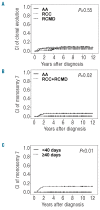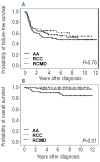Comparison of long-term outcomes between children with aplastic anemia and refractory cytopenia of childhood who received immunosuppressive therapy with antithymocyte globulin and cyclosporine
- PMID: 26273061
- PMCID: PMC4825303
- DOI: 10.3324/haematol.2015.128553
Comparison of long-term outcomes between children with aplastic anemia and refractory cytopenia of childhood who received immunosuppressive therapy with antithymocyte globulin and cyclosporine
Abstract
The 2008 World Health Organization classification proposed a new entity in childhood myelodysplastic syndrome, refractory cytopenia of childhood. However, it is unclear whether this morphological classification reflects clinical outcomes. We retrospectively reviewed bone marrow morphology in 186 children (median age 8 years; range 1-16 years) who were enrolled in the prospective study and received horse antithymocyte globulin and cyclosporine between July 1999 and November 2008. The median follow-up period was 87 months (range 1-146 months). Out of 186 patients, 62 (33%) were classified with aplastic anemia, 94 (49%) with refractory cytopenia of childhood, and 34 (18%) with refractory cytopenia with multilineage dysplasia. Aplastic anemia patients received granulocyte colony-stimulating factor more frequently and for longer durations than other patients (P<0.01). After six months, response rates to immunosuppressive therapy were not significantly different among the 3 groups. Acquisition of chromosomal abnormalities was observed in 5 patients with aplastic anemia, 4 patients with refractory cytopenia of childhood, and 3 patients with refractory cytopenia with multilineage dysplasia. Although the cumulative incidence of total clonal evolution at ten years was not significantly different among the 3 groups, the cumulative incidence of monosomy 7 development was significantly higher in aplastic anemia than in the other groups (P=0.02). Multivariate analysis revealed that only granulocyte colony-stimulating factor administration duration of 40 days or more was a significant risk factor for monosomy 7 development (P=0.02). These findings suggest that even the introduction of a strict morphological distinction from hypoplastic myelodysplastic syndrome cannot eradicate clonal evolution in children with aplastic anemia.
Copyright© Ferrata Storti Foundation.
Figures


References
-
- Baumann I, Niemeyer CM, Benett JM, Shannon K. Childhood myelodysplastic syndrome. In: Swerdlow SH, Campo E, Harris NL, et al., eds. World Health Organization Classification of Tumors of Haematopoietic and Lymphoid Tissues. Lyon: IARC Press; 2008:104–107.
-
- Kosaka Y, Yagasaki H, Sano K, et al. Prospective multicenter trial comparing repeated immunosuppressive therapy with stem-cell transplantation from an alternative donor as second-line treatment for children with severe and very severe aplastic anemia. Blood 2008;111(3):1054–1059. - PubMed
-
- Yang W, Zhang P, Hama A, et al. Diagnosis of acquired bone marrow failure syndrome during childhood using the 2008 World Health Organization classification system. Int J Hematol 2012;96(1):34–38. - PubMed
-
- Niemeyer CM, Baumann I. Classification of childhood aplastic anemia and myelodysplastic syndrome. Hematology Am Soc Hematol Educ Program 2011;2011:84–89. - PubMed
Publication types
MeSH terms
Substances
Supplementary concepts
LinkOut - more resources
Full Text Sources
Other Literature Sources
Medical

